List of 10 Famous Gustav Klimt Paintings
The Kiss
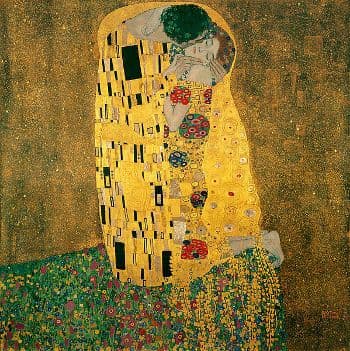
The most famous of all Gustav Klimt paintings, the central piece of the Vienna Secession art movement and one of the finest artworks of the early modern period, The Kiss depicts two lovers embraced on the edge of a flower field or meadow. The painting thrilled the art critics when first presented in 1908 and the Österreichische Galerie Belvedere bought it immediately despite the fact that it was unfinished. The artist completed the 70.8 in x 70.8 in (180 x 180 cm) painting in 1909. Ever since, it can be admired in the Österreichische Galerie Belvedere in the Austrian capital of Vienna.
Portrait of Adele Bloch-Bauer I

The Portrait of Adele Bloch-Bauer I, completed in 1907, is the first of two Klimt’s portraits of Adele Bloch-Bauer, wife of an influential industrialist who financially supported the artist. The last painting from Klimt’s so-called Golden Phase series was supposed to be donated to the Österreichische Galerie Belvedere after Adele’s death but her husband kept the 54 x 54 in (138 x 138 cm) masterpiece. During the Nazi occupation of Austria, the painting was confiscated which later led to a dispute over the ownership between the State of Austria and Bloch-Bauer heirs who eventually won the “battle”. In 2006, the portrait was purchased by Ronald Lauder for the Neue Galerie New York for $135 million.
The Virgin (Die Jungfrau)
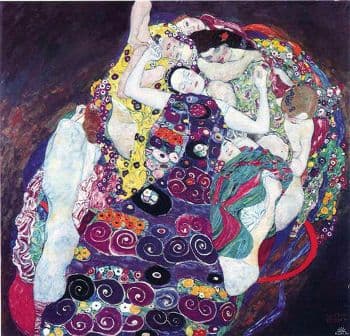
The Virgin (Die Jungfrau) is a 74.8 x 78.7 in (190 x 200 cm) oil on canvas which depicts a virgin surrounded by six nude women. The painting that was completed in 1913 has several different interpretations in regard to its meaning, with the dominant being that it represents the transformation into womanhood. This interpretation is supported by the spirals on the drapery which are argued to symbolize fertility and the Virgin’s parted legs indicating sexual maturity. One of the central pieces of Klimt’s allegorical paintings can be admired in the National Gallery in Prague, the Czech Republic.
Danaë
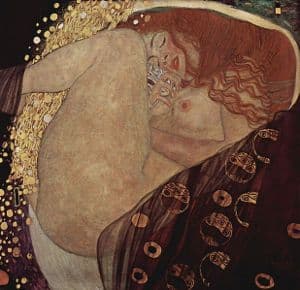
Danaë is a 30 x 33 in (77 x 83 cm) oil painting that depicts the daughter of the mythical King Acrisius of Argos. The latter, curious about his future, goes to the Delphi Oracle which tells him that he will one day be killed by Danaë’s son. To prevent this from happening, the King has his daughter imprisoned in a bronze chamber to keep her childless. One night, however, she is visited by Zeus who comes to her in the form of golden rain and impregnates her. Klimt “captured” the moment of Zeus’ coming to Danaë which clearly indicates the golden rain between her legs. The painting which was completed in 1907 is today displayed in the Galerie Würthle in Vienna, Austria.
The Three Ages of Woman
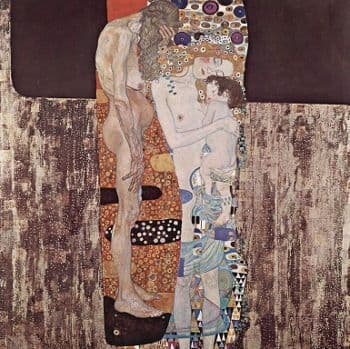
Completed in 1905, the 78 x 70 in (198 x 178 cm) painting, titled The Three Ages of Woman (sometimes also referred to as the Mother and Child) depicts three women at three different stages of life: childhood, young adulthood/motherhood and old age. The old woman who is covering her face with a hand is thought to be inspired by Auguste Rodin’s statue The Old Courtesan. The painting was presented to the public for the first time in 1910 in Venice, Italy. Two years later, it was purchased by the National Gallery of Modern Art in Rome, Italy, where it has been housed ever since.
Judith and the Head of Holofernes (Judith I)
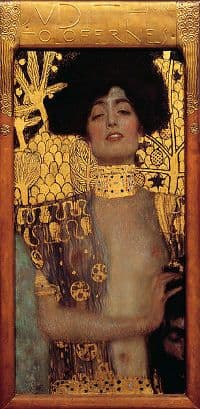
Also called Judith I, the Judith and the Head of Holofernes is a 33 x 17 in (84 x 42 cm) oil painting which, like its name reveals, depicts the Biblical widow Judith holding a head of the Assyrian general Holofernes. The beautiful Hebrew widow entered the enemy camp to seduce the general and gain his trust with an aim to kill him as soon as getting the chance to do so. One night Holofernes gets dead drunk and the beautiful widow takes the opportunity to decapitate him by which she helps the Israelites defeat the invader. The painting that was completed in 1901 is today on display in the Österreichische Galerie Belvedere in Vienna, Austria.
Portrait of Fritza Riedler
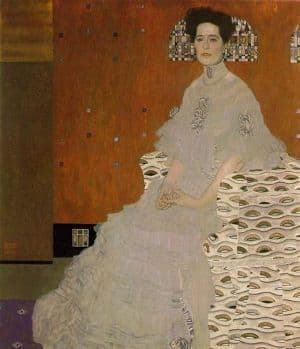
The 59.8 x 52.7 in (152 x 134 cm) oil on canvas depicts the wife of the Austrian mechanical engineer Alois Riedler. One of Klimt’s most famous portrait paintings - highly “fashionable” among Vienna’s elite at the time - is admired for an outstanding contrast between naturalism and three-dimensional effect. The latter is highlighted by geometric elements on the armchair and the wall feature behind Fritza’s head which on the one hand, complements the “geometric” armchair and on the other, draws attention to the face. Like many other Klimt paintings, the Portrait of Fritza Riedler (completed in 1906) is today held in the Österreichische Galerie Belvedere.
Hope II
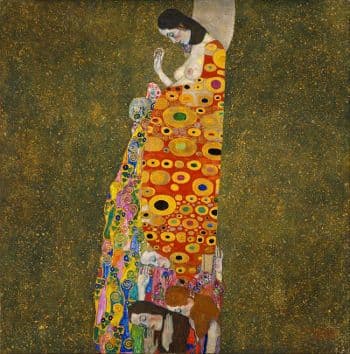
Painted in 1907-08, Hope II depicts a pregnant woman with bare breasts and elaborate shawl. Her head is bent towards her belly featuring a human skull which is thought to represent death or danger to her unborn child. The woman is thought to be either in pray for her child or worried about the impeding threat. At her feet are three female figures with their heads bent as well - either in pray or mourning over the fate of the child. The 43.5 x 43.5 in (100.5 x 110.5 cm) masterpiece is today on display in Gallery 4 of the Museum of Modern Art (MoMA), New York City.
Beethoven Frieze

Klimt painted one of his most famous artworks - the Beethoven Frieze - on the walls of the late 19th century Secession Building in Vienna for the 1902 Vienna Secessionist Exhibition. After the end of the exhibition, the artist’s depiction of human quest for happiness was removed from the walls and sold to a collector. In the 1970s, it was bought by the State of Austria to make it available for public viewing. But this didn’t happen until 1986 when it was displayed again in a specially designed room in the Secession Building.
Death and Life
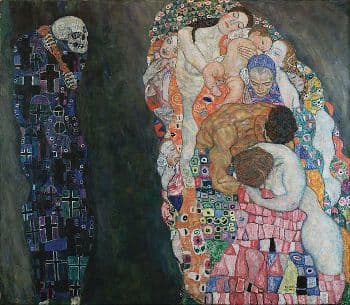
Painted in 1910, the 70 x 78 in (178 x 198 cm) oil on canvas is an allegory of life and death. Death depicted in the form of a human skeleton in dark robe on the left is presented as a perpetual threat to people, both young and old. The overall message of the painting, however, is positive. Death may lurk around the corner and indiscriminately take life but it cannot win against the never ending circle of life. One of Klimt’s greatest masterpieces can today be admired in the Leopold Museum in Vienna, Austria.